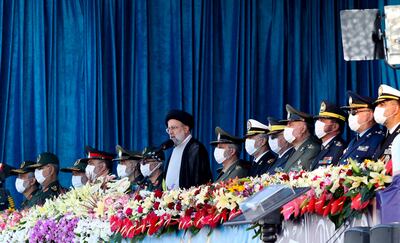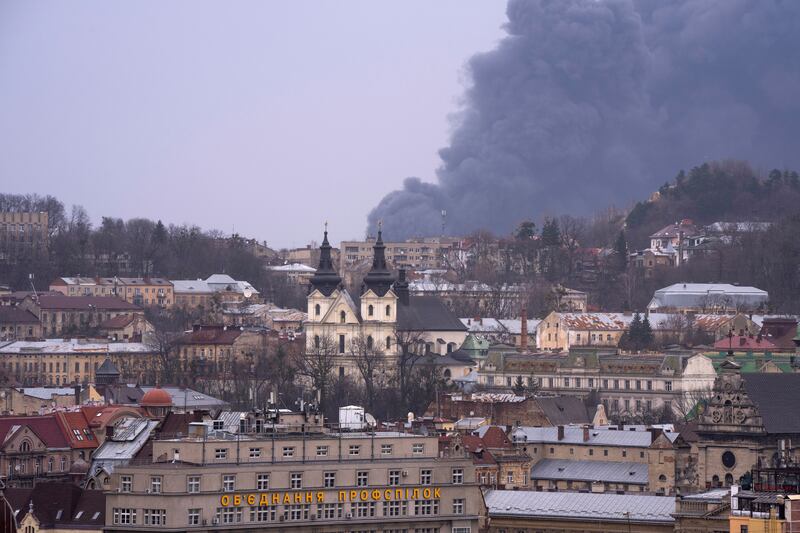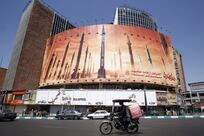The Ukraine war is entering a dangerous phase as fighting intensifies in the city of Mariupol and the Donbas region in the country’s east.
Red lines between Moscow and Nato seem to be constantly shifting, with no guarantee that the rest of Europe will not be drawn into the conflict at some point in the future.
A battle of wills and wits, meanwhile, is under way between US President Joe Biden and Russian President Vladimir Putin. Both leaders are seemingly digging in their heels.
At a time when Russia has shifted its focus to the Donbas region, where a significant Russian-speaking population lives, Mr Biden is making statements pointed at Mr Putin. At one stage, he appeared to call for regime change in Moscow, although he and his administration later walked back those remarks.
But now, Washington is taking “a closer look” at whether to label Russia a state sponsor of terrorism. It is a process that would not just complicate US-Russia relations but also relations between the Europeans and Moscow. Were such an official announcement to be made, the Kremlin would consider it a “red line”, since that would lead to the total severing of diplomatic relations with the US.
Russia’s test of the Sarmat missile this week did not surprise Washington, which said Moscow had given prior notice about it. Yet the timing has important implications. At the launch, Mr Putin said the new missile has no analogue in the world and wouldn’t have one for a long time to come. It would, he claimed, make those who try to threaten Russia “think twice”.
Listing Russia as a state sponsor of terrorism is not the only factor that motivated the missile test, but also the influx of American weaponry to Ukraine coupled with Washington’s economic boycott of Russia. Because the Biden administration is Kyiv’s primary backer, funder and materiel provider, the message Moscow sought to convey by testing its missile was likely aimed at the US and its Nato allies.
Nato’s materiel support has put Moscow in a bind. Russian Foreign Minister Sergey Lavrov has hinted that its shipments could become legitimate targets for the Russian armed forces. But will the Kremlin risk drawing Nato into the conflict by disrupting deliveries of weaponry crucial to the Ukraine government’s staying power? After all, destroying Nato arms shipments will almost certainly broaden the conflict.
What will the Biden administration do if that were to happen? Will Nato members be ready for a broader war? These are questions that the West needs to think through as well.
Moscow’s military challenges, meanwhile, are increasing by the day. It needs to wrap up its operations in Mariupol in order to be able to pour much-needed resources into Donbas. But even if it prevails in Mariupol, it will have to fight 60,000 well-armed, well-prepared and highly motivated Ukrainian soldiers in Donbas. And it’s only after the Russians win in Donbas can they enter the third phase of the war, which is to capture Odessa and Kyiv.
Moscow, one may assume at this point, is likely to be caught in a long-drawn-out conflict.

What does this mean for Mr Biden? The brief answer is a recalibration of priorities.
It’s been only a little more than a year since he took office, but it bears reminding that until the war in Ukraine broke out, the President was focused primarily on reviving the 2015 Iran nuclear deal – called the JCPOA – that Donald Trump, his predecessor, had pulled the US out of four years ago. This seems no longer a priority, particularly as Russia is a joint signatory of the original agreement and whose co-operation is vital for JCPOA 2.0 to see light of day.
The weeks-long violence in Israel involving its own security forces as well as Hamas in Gaza have also constrained the Biden administration’s movements linked to talks with Iran. The US, after all, is a key ally of Israel.
The Iranians understand that it is unrealistic to expect any immediate breakthrough on the nuclear issue, despite talk about the importance of Iran’s oil in the time of growing embargoes on Russian oil, but it has put the Iranian regime in a tight spot. For reviving the JCPOA would have meant lifting sanctions against Iran and the subsequent unlocking of much-needed funds for Tehran and its eventual re-integration into the global economic system. This, in turn, would have led to the unfreezing of funds for the regime’s all-important Islamic Revolutionary Guard Corp (IRGC) to continue its destabilising activities in the Middle East, especially in Iraq, Lebanon, Syria and Yemen.
Caught in the US-Russia standoff, Tehran is attempting to sell a “promise” that the IRGC – which oversees proxy militias in the aforementioned countries – will not carry out operations outside Iran. No one believes this promise, of course, because that would mean undermining the very raison d’etre of the so-called Islamic Republic, which is to export its ideology to the Arab world.
With time, the ripple effects of the Ukraine war – including the fate of the JCPOA – will become increasingly clear. For now, unfortunately, the rest of the world simply has to contend with the lack of order or rules.





